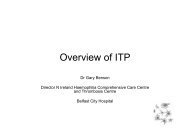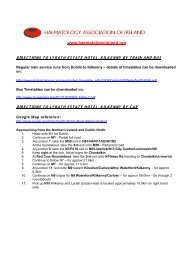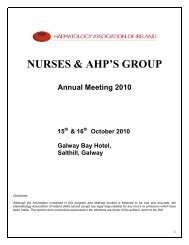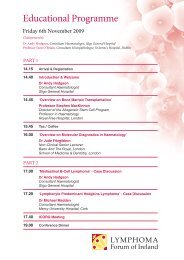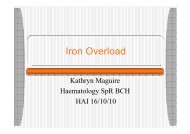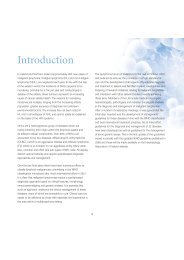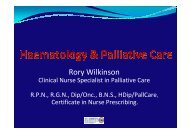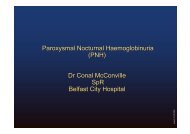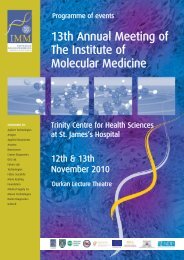Guidelines on Diagnosis and Treatment of Malignant Lymphomas
Guidelines on Diagnosis and Treatment of Malignant Lymphomas
Guidelines on Diagnosis and Treatment of Malignant Lymphomas
Create successful ePaper yourself
Turn your PDF publications into a flip-book with our unique Google optimized e-Paper software.
Mediastinal (Thymic)<br />
Large B-Cell Lymphoma<br />
Definiti<strong>on</strong> <strong>and</strong> incidence<br />
Mediastinal (thymic) large B-cell lymphoma (med-DLBCL) is a<br />
subtype <strong>of</strong> DLBCL <strong>of</strong> putative thymic B-cell origin arising in the<br />
mediastinum which has distinctive clinical, immunophenotypic<br />
<strong>and</strong> genetic features. It primarily affects people in the third or<br />
fourth decades with a female:male ratio <strong>of</strong> 2-4:1 <strong>and</strong> has an<br />
incidence rate <strong>of</strong> .25/100,000/year.<br />
ICD – O Code 9679/3<br />
Clinical Presentati<strong>on</strong><br />
Patients present with localized disease <strong>and</strong> signs <strong>and</strong> symptoms<br />
related to large anterior mediastinal masses, sometimes with<br />
superior vena cava obstructi<strong>on</strong>, pleural <strong>and</strong>/or pericardial<br />
effusi<strong>on</strong>s. Disease at extranodal sites is frequently present at<br />
relapse involving the CNS, liver, adrenal gl<strong>and</strong>s, kidneys <strong>and</strong><br />
gastrointestinal tract.<br />
Pathology <strong>and</strong> Genetics<br />
There is marked diffuse lymphoid proliferati<strong>on</strong> associated with<br />
variably dense compartmentalizing fibrosis. Immunohistochemical<br />
staining with cytokeratin markers may identify thymic remnants<br />
<strong>and</strong> resemble carcinoma. The neoplastic cells are medium to<br />
large sized cells, typically with abundant pale cytoplasm <strong>and</strong><br />
oval nuclei. Some cases exhibit more pleomorphic nuclei.<br />
An admixture <strong>of</strong> benign small lymphocytes <strong>and</strong> eosinophils<br />
may suggest Hodgkin Lymphoma <strong>and</strong> occasi<strong>on</strong>ally Med-DLCBCL<br />
<strong>and</strong> Nodular Sclerosis Hodgkin Lymphoma (NSHL) may co-exist<br />
as a composite lymphoma.<br />
Immunophenotype<br />
Med-DLBCL expresses CD45 (CLA) <strong>and</strong> classical B-cell markers<br />
such as CD19 <strong>and</strong> CD20. CD30 is expressed in >80% <strong>of</strong> cases<br />
but is <strong>of</strong>ten weak <strong>and</strong> heterogenous. CD15 is usually negative,<br />
IRF4/MUM1 <strong>and</strong> CD23 are positive in >75% <strong>of</strong> cases. CD10 is<br />
rarely positive (



